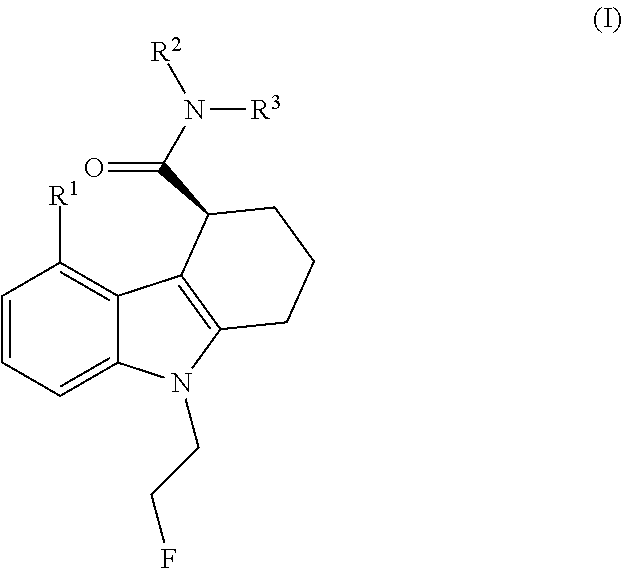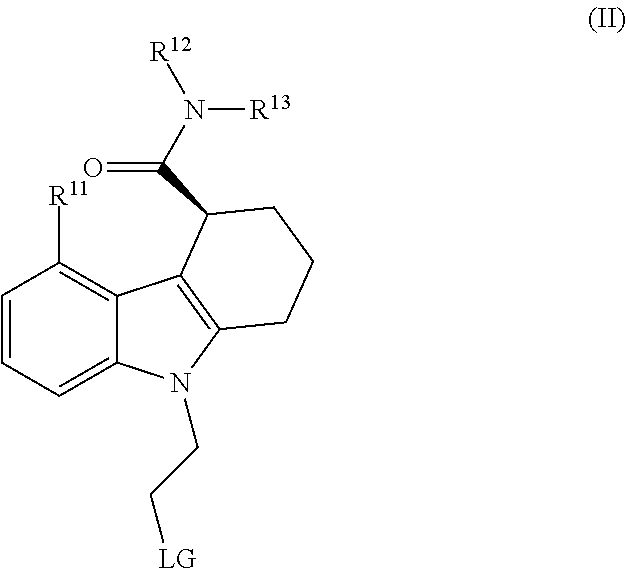Carbazole compounds for in vivo imaging
a compound and in vivo imaging technology, applied in the field of in vivo imaging, can solve the problems of high plasma protein binding, difficult synthesis, low brain penetration, etc., and achieve the effect of improving the binding properties
- Summary
- Abstract
- Description
- Claims
- Application Information
AI Technical Summary
Benefits of technology
Problems solved by technology
Method used
Image
Examples
example 1
Prior Art Compounds
Example 1(i): PK11195
[0079]
[0080]PK11195 is commercially available.
Example 1(ii)
N-(2-methoxybenzyl)-N-(4-phenoxypyridin-3-yl)acetamide (PBR28)
[0081]
[0082]Non-radioactive PBR28 is commercially available.
example 1 (
Example 1(iii)
Non-radioactive 9-(2-Fluoro-ethyl)-5-methoxy-2,3,4,9-tetrahydro-1H-carbazole-4-carboxylic acid diethylamide (known as “GE180”)
[0083]
[0084]A non-radioactive version of the prior art compound 9-(2-Fluoro-ethyl)-5-methoxy-2,3,4,9-tetrahydro-1H-carbazole-4-carboxylic acid diethylamide (known as “GE180”) was prepared according to the method described by Wadsworth et al (2012 Bioorg Med Chem Letts; 22: 1308-1313) and in Examples 2 and 14 of WO 2010 / 109007.
example 2
Synthesis of (S)-N-benzyl-N-ethyl-9-(2-fluoroethyl)-2,3,4,9-tetrahydro-1H-carbazole-4-carboxamide (Non-radioactive Compound 1 of the Invention)
[0085]
[0086]The racemate was synthesised as described by Wadsworth et al (2012 Bioorg Med Chem Letts; 22: 1308-1313).
[0087]SFC chiral separation was used to separate out the S-enantiomer using the following conditions:
CO2: AGA SFC gradeColumn: Whelk-01 10 × 250 mm, 5 μm,100 ÅFlow: 13 ml / minPressure: 100 barTemp: 40° C.Eluent: 40% MethanolInjection concentration: 144 mg / mlInjection solvent: DioxaneInjection volume: 100 μLS-enantiomer: Retention time: 3.3 min, purity 98%R-enantiomer: Retention time: 7.4 min, purity 100%
PUM
| Property | Measurement | Unit |
|---|---|---|
| Capacitance | aaaaa | aaaaa |
| Biocompatibility | aaaaa | aaaaa |
| Distribution | aaaaa | aaaaa |
Abstract
Description
Claims
Application Information
 Login to View More
Login to View More - R&D
- Intellectual Property
- Life Sciences
- Materials
- Tech Scout
- Unparalleled Data Quality
- Higher Quality Content
- 60% Fewer Hallucinations
Browse by: Latest US Patents, China's latest patents, Technical Efficacy Thesaurus, Application Domain, Technology Topic, Popular Technical Reports.
© 2025 PatSnap. All rights reserved.Legal|Privacy policy|Modern Slavery Act Transparency Statement|Sitemap|About US| Contact US: help@patsnap.com



